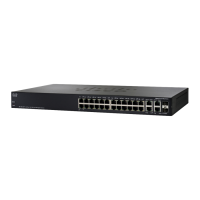Configuring IP Information
Management and IP Interfaces
Cisco Small Business 300 Series Managed Switch Administration Guide 178
15
• When the ISATAP router IPv4 address is not resolved via the DNS process,
the ISATAP IP interface remains active. The system does not have a default
router for ISATAP traffic until the DNS process is resolved.
To configure an IPv6 Tunnel:
STEP 1 In Layer 2 mode, click Administration > Management Interface > IPv6 Tunnel.
In Layer 3 mode, click IP Configuration > Management and IP Interface > IPv6
Tunnel.
The IPv6 Tunnel Page opens.
STEP 2 Enter the values for the following fields:
• Tunnel Number—Displays the automatic tunnel router domain number.
• Tunnel Type—Always displayed as ISATAP.
• Source IPv4 Address—Disable the ISATAP tunnel, or enable the ISATAP
tunnel over an IPv4 interface. The IPv4 address of the selected IPv4 interface
used to form part of the IPv6 address over the ISATAP tunnel interface. The
IPv6 address has a 64-bit network prefix of fe80::, with the rest of the 64-bit
formed by concatenating 0000:5EFE and the IPv4 address.
-
Auto
—Automatically selects the lowest IPv4 address from among all of
its configured IPv4 interfaces.
-
None
—Disable the ISATAP tunnel.
-
Manual
—Manually configure an IPv4 address. The IPv4 address
configured must be one of the IPv4 addresses at the switch IPv4
interfaces.
• Tunnel Router's Domain Name—A global string that represents a specific
automatic tunnel router domain name. The name can either be the default
name (ISATAP) or a user defined name.
• Query Interval—The number of seconds from 10-3600 between DNS
queries (before the IP address of the ISATAP router is known) for this tunnel.
The interval can be the default value (10 seconds) or a user defined interval.
• ISATAP Solicitation Interval—The number of seconds from 10-3600
between ISATAP router solicitations messages, when there is no active
ISATAP router. The interval can be the default value (10 seconds) or a user
defined interval.

